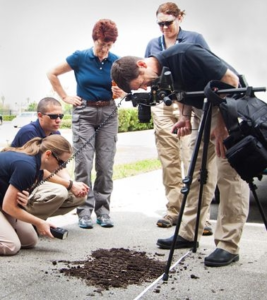
The unique properties of soil are as follows:
Sediment– the original solid particles that were weathered and transported. This could be in the form of a grain of rock that breaks off of the larger parent material (larger version of rock). Soils can develop on these sediments due to physical and chemical alteration.
Color– indicates its history as well as the compounds present in the soil. For example, white or gray soil could mean that the soil contains lime or has been leeched((a chemical, a metal, etc.) from a substance by the action of a liquid passing through the substance. Gray soil can also mean that the organic material or moisture is present, black soil suggests the same. Soil that is red,brown or yellow generally suggests that there is iron present.
Structure-indicates whether a soil is composed of a single grain particle or not. This is determined by the presence of peds (clumps). These peds are formed due to cementing agents such as calcium carbonate attracting the soil particles so that they adhere to each other to form either bulky peds which are small conglomerates (masses) or platy peds which are flat and sheet like.
Soil samples can be collected in different ways depending on where the sample is being collected from. If samples are being collected indoors or from a vehicle vacuuming is generally used. If the sample is outdoors it’s collected by placing a teaspoon of soil into a plastic vial. When found on a tool, it is wrapped in plastic and then sent to the lab for testing. Collecting soil samples off of a body isn’t any harder than collecting a sample from anywhere else but it takes more work and care so that the evidence doesn’t get contaminated. When collecting samples from a body, samples should be taken at regular intervals and a different spoon should be used each time.
Once the soil samples are collected they are sent to the laboratory. At the laboratory samples should be separated by samples from the victim and samples pertaining to the suspect. Also, each sample set should get its own examiner. This is to avoid contamination; if possible the samples should be kept in different rooms. To examine the samples the examiner will first want to use microscopic analysis to perform testing on the mineral content. Another test that can be done to help try to identify the origin of the soil is a density test. The density test is called the density gradient tube. This test consists of adding liquid to two glass tubes. The liquid in both tubes is the same, but the rations are different. This represents two different densities. The soil sample is added to both liquid samples. After the soil samples become suspended in the liquid the separation of the bands can then be analyzed to reveal the profile of the soil. Heat tests can also be used to test the soils reaction and electron microscopes can be used to examine the structure of the minerals in the soil. During examination, an examiner might find that some soil samples may contain biological evidence such as saliva, semen or blood. If biological evidence is found in the sample the whole soil sample should be sent to the laboratory for testing.
Back to Crime Library
|
|
|
